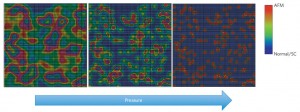Antiferromagnetic Droplets in a Quantum Critical Superconductor

Our work on the superconducting heavy fermion compound CeCoIn5 has appeared in the journal Nature Physics: Disorder in quantum critical superconductors. Work at UC Davis several years ago by former graduate student Long Pham under the direction of Prof. Zach Fisk led to the important discovery that the ground state of CeCoIn5 could be tuned by replacing some of the In with Cd. Surprisingly, the Cd appeared to act as the reverse of pressure, leading to the emergence of antiferromagnetism for sufficient doping. Our NMR work suggested that microscopically, the Cd was acting to locally nucleate antiferromagnetic droplets, much the same way as tiny crystals nucleate rain in a supersaturated cloud. The key here is that pure CeCoIn5 is on the border of antiferromagnetism (it is a quantum critical system), thus the Cd dopants “seed” antiferromagnetic droplets.
In order to test this hypothesis, several tests were conducted under hydrostatic pressure, including specific heat, resistivity, and NMR measurements – by an international team of collaborators from the US, South Korea, and Russia. By applying pressure, the CeCoIn5 was tuned away from the quantum phase transition, and hence the size of the droplets was reduced. For sufficiently high pressures, the droplets no longer interact and therefore long range antiferromagnetic order never develops. This work is important because it means that local phenomena can play a significant role in quantum critical materials, and that doping is not necessarily a proper tuning parameter.
